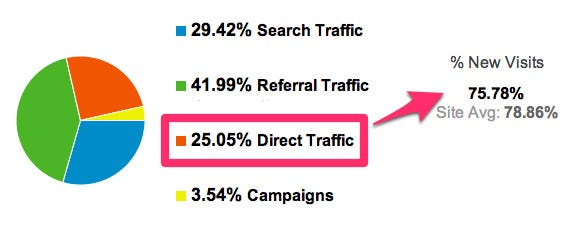Growww #2: The traffic source we all love, but hate.
Basic growth tips for your online presence (Growww Series — Part 2 of 10)
From the first time that you create a website or blog and you install an analytics program, you’re most likely hooked on the practice of tracking your site visitors. Seeing where your site visitors are located, how they arrived to your site, what pages they visited, and how long they stayed on your site is fun and addictive – especially if you are using one of the many “real-time” analytics programs.
Case: Melissa Muffintop, Owner of the Muffintop Bakery

Thanks creativecommons.org!
Melissa was a 40-something year old business owner who took her first leap into the world of e-commerce. She hired a top-tier web design firm (her 13-year old cousin’s best friend) that launched her site using http://getfwd.com/ (the best open-source e-commerce platform).
A few days later…
Melissa Muffintop: “Oh my goodness! Over one-thousand people have already visited my site and I just launched! I must have the best muffins ever!”
“China! India! Puerto Rico! I’m worldwide!”
Unfortunately for Miss Muffintop, all of her “people” were all bots…but she did not know until it was too late. Not even the top-tier web design firm with 13 years of experience was able to foresee the effects of this.
Her excitement made her oblivious to the fact that none of the visitors actually purchased muffins from her site. She decided to get a loan from the loan sharks to prepare her infrastructure for these massive worldwide orders that she had envisioned.
The rest was history…
As much fun as it is to track visitors, analytics data should not be viewed as being completely accurate. In most cases, the most accurate statistics will come directly from the server, and even those stats are not 100%. In general, there are three types of traffic covered in your typical program.
The Three Standard Types of Traffic Data

The analytics program that most new website owners start off with is Google Analytics, because it’s well known, fairly sophisticated, and free to use. Google Analytics classifies all traffic as originating from one of three primary sources: search, referral, and direct, so your visitors found your site via a search result, were referred to your site from a link on another site, or typed your URL in the address bar (or returned via a bookmark).
Search Traffic – This is the entire reason for Search Engine Optimization (SEO) efforts – we want people to be able to find our sites when they search relevant keywords. These new visitors discover our sites and are exposed to the products and services that we offer.
Referral Traffic – Visitors who click on a link in a tweet, a Facebook post, or a link on another website – perhaps from a review of your site, are counted as referrals in Google Analytics. These referrals tend to results from social media activity, online campaigns, reviews, and links from guest posts.
The links from both of these sources often have tags that associate them to particular campaigns which can provide the website owner with valuable information as to the effectiveness of their online advertising and social media efforts.
Direct Traffic – When a URL is typed into the browser address bar or a bookmark is clicked, the result is direct traffic. The importance of this category of traffic is often overlooked in the rush to attract new visitors. Direct visitors are important because they are either:
· Returning visitors who have returned on their own – with no invitation and no effort to get them to revisit expended. These visitors thought enough about your site the first time to want to come back.
· New visitors, who by typing your URL into the address bar, are responding to offline advertising. They saw a flyer, a press release or a news item, heard your web address on the radio or a podcast, or learned of your site via word of mouth, which prompted them to visit your site.
So, why is “direct” my #1 traffic source month after month? Make it stop!

One of the major problems with all tools is that too often, unidentifiable traffic results are forced into the “direct” category because the analytics program cannot determine the traffic’s true source. It can be a huge hindrance for growth, because far too often,a large portion of your sales, subscribers, and profitable traffic come from this unknown “direct” source. There are dozens of contributors, most commonly:
· Improper installation of the tracking code
· Too many tracking / analytics scripts running on the same page
· Link shortening
· Improper UTM structure
· Just because
Just as it is generally much more expensive to attract a new customer as it is to retain an old one, getting repeat visitors or visitors who purposefully seek out your site are analytics that are worth tracking. Unfortunately, the issues mentioned earlier often obscure this very important traffic measure.
So, what can you do to take action?

1) Add UTM tags to your links where possible to identify the sources amongst yourself. UTM tags allow the user to send more data to the analytics program, in hopes for better tracking:
http://gaconfig.com/google-analytics-url-builder/
2) Place your analytics code near the top of your page
By default, most JavaScript is placed near the bottom of the page, to allow the visual elements to load faster. Unfortunately, when your analytics script loads last (if at all), you tend to lose or corrupt a large amount of data.
3) Stop using so many tracking programs!
If you feel that one is not working, replace it with another. Too many scripts attempting to pull the same information lead to a bunch of ambiguous data.
4) Use DNS Prefetching on your tracking scripts:
Since many tools are from third parties and their scripts are hosted on a remote location, this will allow quick access and enhance loading times for these scripts. You can read more about this here: http://davidwalsh.name/dns-prefetching
5) Use a real analytics program
Although Google Analytics allows you to track a portion of your user data in depth, there’s a lot more to it. I recommend one of the following:
a. MixPanel (http://mixpanel.com)
b. KissMetrics (http://kissmetrics.com)
c. StatCounter (http://statcounter.com)
Even with all of the above, you must remember that a large majority of the time, your visitors will not only be influenced by one traffic source, but by many. A visitor may visit your site via search, and return when you hit them with a retargeting campaign from another site, or they may run across your site again by viewing an article on a related site.
Many companies, including Google have realized this and are starting to enhance cater to the “multi-channel” funnels in attempt to give a better look on how your users are really being influenced across the web.
R.I.P. Melissa Muffintop

